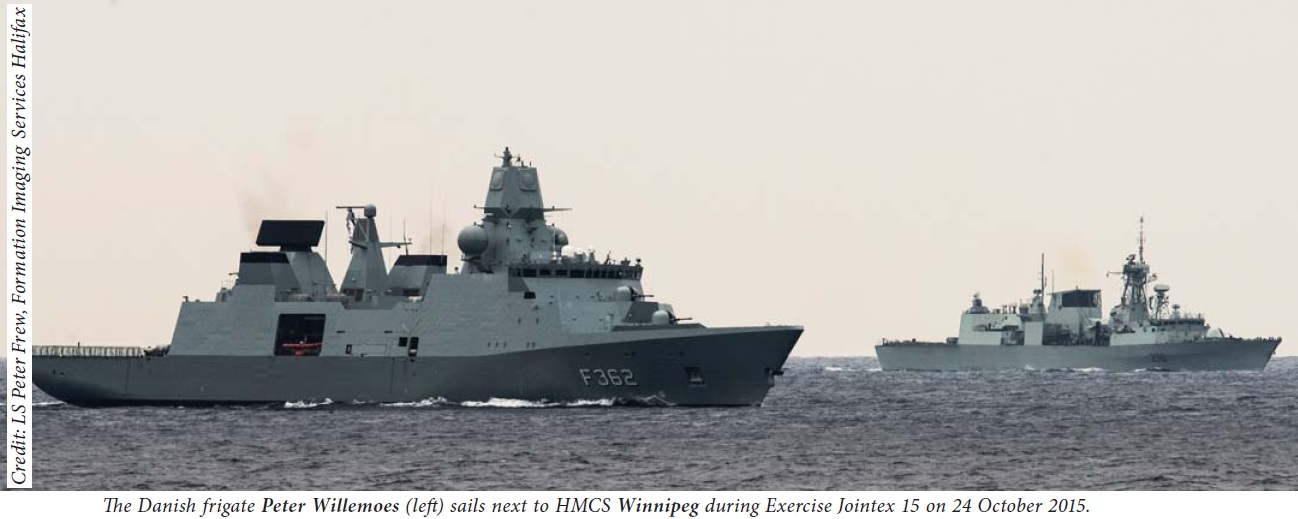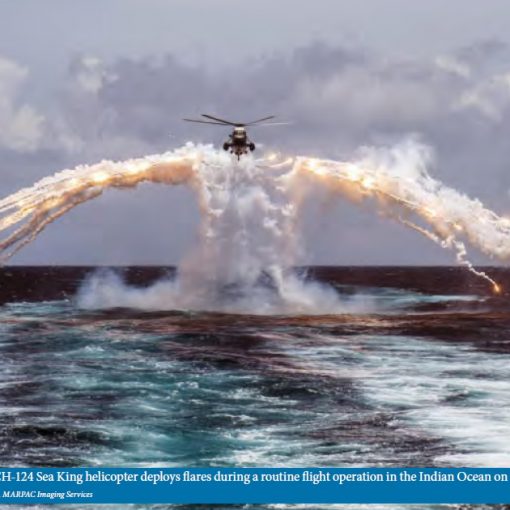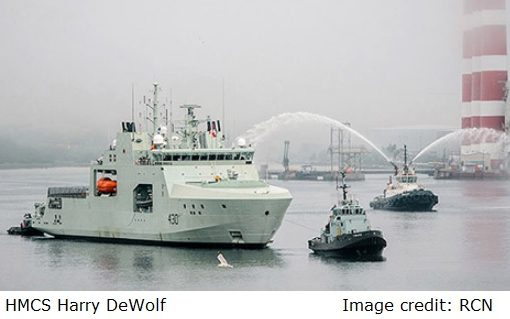David Dunlop
Now that the Canadian government has entered the decision phase for the bids entered for the rights to build 15 Canadian Surface Combatant (CSC) ships, it is time to give an opinion as to which of the three bids entered will be the best fit for Canada’s future naval fleet. The backbone of this future fleet will be vessels that see Canada through the next few decades, and must be judiciously chosen. There are several new designs of warships being presented to Canada and pros and cons with all of them. Spanish, Dutch and British companies have all answered the Requests for Proposals (RFPs) within the time-frame. Spain is offering its F-100 Christopher Columbus-class, the Dutch are offering their De Zeven Provincien-class and the Lockheed-Martin (LM)/British Aerospace Electric (BAE) consortium is offering their Type 26 frigate. The Italian/French consortium RFP was disqualified as they did not submit the proposal within the time limit. Canada expects to make a decision on the winning bid by the Spring of 2018.
All companies have multi-purpose frigates either in service, under construction or planned that can do the job. The German Type 126/MKS 180 Saxony-class – which is not one of the bids in the CSC competition – is particularly interesting, with its strengthened hull for Arctic operations. But there is only one design for Canada that offers a balanced ‘plug & play’ approach and that design is, without question, the LM/BAE consortium Type 26 frigate. This ship exceeds Canada’s high-level requirements, will be deployable worldwide for extended periods and would be more than capable of replacing our anti-air, anti-surface and anti-submarine capabilities with one single class of ship. The Australian Navy has the BAE Type 26 frigate on its short list to replace its aging frigates as well. No other ship design compares to meet Canadian naval requirements, including the Italian/French FREMM-class, the German Type 126/MKS 180 Frigate, the Spanish F-100 Christopher Columbus-class or the Dutch De Zeven Provincien-class.
The LM/BAE Type 26 frigate is a cutting-edge warship that is simply the best fit for Canada’s future workhorse navy. It is a modern new warship with all the capabilities Canada requires in a CSC. The Type 26 is infinitely adaptable, can easily be reconfigured and the RCN can tweak the design to cater to its own development requirements which is where the Type 26 has the potential to excel. A reconfigurable mission bay can accept containerized loads to allow the rapid reloading of the vessel. Such loads might include aid/rescue packages, underwater vehicles, boats or naval drones.
The Type 26 frigate is 149.9 metres (492 ft) in length and has a maximum beam of 20.8 metres (69 ft) and a displacement of 7,000+ tons. A CODELOG (Combined Diesel Electric or Gas Turbine-MT 30) configuration is deployed in the ship, giving it a top speed in excess of 29+ knots with 4 x 20V 4000 M53 diesel generators. It has a MK 41 VLS system that can accommodate surface, air and land attack missiles. It has a 5" 62 caliber Mk. 45 medium range gun along with 2 X 30mm, 2 X CIWS & 2 X mini-gun systems and can be fitted with future Canadian torpedos and counter-measures. It will accommodate Canadian hull-mounted and towed array sonar systems that are vital to long-range submarine detection. Its large flight deck can easily handle the CH 148 Cyclone helicopter in its hanger, with the ability to land heavy-lift Chinook helicopters. Its hangar facilities are also large enough to accommodate maritime unmanned aerial vehicles (UAVs) along with a flexible mission bay.
It can undertake a wide range of roles from high-intensity conflicts including anti-submarine, anti-surface warfare and area-air defence, along with the ability to aid in humanitarian assistance and disaster relief (HA/DR) operations. The Type 26 is flexible, versatile and highly survivable with an extremely low acoustic signature. It exceeds all Canadian naval requirements, and will accommodate Canada-specific modular design sub-systems with open systems architecture. These same features will minimize ownership costs and facilitate Canadian industry playing a major role in through-life support and upgrades, delivering long-term economic benefits to Canada. Its low acoustic signature, crucial to evading detection from submarines, will translate into safety and survivability of the crew, and the ability of the ship to successfully complete its missions. Accommodations are included for 208 crew, with a core complement of 118 sailors.
A major part of the ship design will be the new Lockheed-Martin state-of-the-art LM CCM 330 Combat System (CS), that will meet all of Canada’s Naval C4ISR requirements. It may only have one drawback – the lack of ice capability to operate in our North. If it had a more strengthened hull, however, that would certainly go a long way to meet the strategic needs for a truly ‘blue’ three-ocean Canadian Navy. It also works well within our time-frame as BAE has already started construction of the Type 26 frigate in July of 2017, about three years ahead of Canada’s future naval frigate requirements.
The LM/BAE Type 26 Canadian Surface Combatant is simply the right solution for Canada’s future naval fleet and at a final cost of between $60/70B CAD, they are still well worth the investment and of course will be built here in Canada.
David Dunlop (RCN PO1NCIOP (Retired)-NATO/QGJM/CD2) is a retired RCN Petty Officer 1st Class Naval Combat Information Officer with over 41 years experience as a Tactical Data Coordinator for Command.






26 thoughts on “Future Canadian Surface Combatant: The Only Option”
Have you or a relative ever been employed by LM or BAE? Sounds like a sales pitch rather than an analysis. Over $4 billion a ship is criminal.
Glen: don’t know where you are getting your figures from, but if you have “really” researched the LM/BAE type 26 you would have known that the British have already cut steel on the first of a batch of 3 type 26 ships last July with a contract to the Scottish shipyards on the Clyde for approx. 3.7 billion pounds or 6.7 billion Cad 2017 dollars or 2.23 billion in 2017 cad dollars per ship. So your figures are grossly inaccurate as of today even with inflation to 2018. I am just a lowly ex-sailor who is passionate about the best ship fit for our future naval fleet! No I have no affiliation with either LM or BAE. If you are going to comment, then please be accurate, and do the research as I have!
David, I used your numbers of 60/70B. That is over 4 Billion per hull. I don’t understand your enthusiasm for a paper ship; and a British one at that. This unproven design that is years away from proving itself should never have been allowed in the competition. But unfortunately it will likely win since it is being backed by LM; Canada’s combat system integrator.
Glen: The use of the $60/70B dollar CAD figure was based on the Canadian Government figures of around $62B CAD for 15 CSC ships. As the winning bid will be coming this Spring 2018, and allowing for inflation, over the coming years, and based on what the British have allocated to build their first 3 Type 26 ships, it looks like the CAD figure will come in well under the $62B mark for 15 ships. Possibly as low as $10B CAD lower. The money saved could possibly go towards a sorely needed Amphibious Sealift Capability perhaps?
Are you kidding me? Amphibious Sealift Capability! No offense, it would be awesome to finally have replaced the loss of the “Bonnie”. But let’s be realistic, any thought of Canada going beyond minimal NATO and sovereignty commitments and requirements from a deployed asset perspective is a pipe dream with any government be it Liberal, Conservative or even, God forbid, NDP.
Furthermore, I am betting dimes to donuts that the winning bid will be for 11 or fewer CSCs! The reason – the government will argue that missions can be extended indefinitely with these new “technical marvels” by inter-changing crews by air for forward deployed CSCs. Canada, unfortunately, is putting all its eggs into one helluva bucket!
Glen, you seem to have so much anger for the British. They have designed a great ship that has already been accepted world wide. Even the U.S. has conceded that it could never match the Type 26 design as they go through their own process. They would never, however, build any other design but their own. Smile Glen! The world will not fall apart when the LM/BAE Consortium wins the bid next month. Be proud of a great ship design. Canada could never match this design even if we tried to design and build a new ship on our own (not cost effective either). Be happy!!
Why is it Canada insists on buying products that have barely left the drawing board and that prove to be more costly in the end? The failed helicopter program is a good example of this. The last thing Canada needs is to pursue a design based on promises and not proven ability.
Rick: The Type 26 although not a “proven” design as yet shows great promise. Several other countries including Australia, and several other countries, are very serious about this design to replace all their older Frigates as well. It is the latest “Common Frigate” design that offers more capabilities that Canada needs than any other “proven” design out there. The other companies are offering designs that are all getting “long in the tooth” and will be obsolete before we even decide on one of the 3 options this Spring (2018).
Do either of the other ships have the capability to house/deploy a VDS? I have looked and could not find any information that they currently do or can. Is this something that they would be adapted to do to meet the RCN requirement?
Dale: Neither the Spanish F-100 Class or the Dutch De Zeven Provincien Class offer a VDS with their bids. They both incorporate Hull Mounted Sonars only. It may be possible to incorporate a Variable Depth Sonar in their design but at what cost? The Type 26 Frigate already offers a hull mounted sonar, a VDS as well as a Towed Array System(TAS). Canada’s TAS could easily replace BAE’s TAS system or incorporate Canada’s Towed Array software. Again, the Type 26 will be the best fit for Canada by far. Cheers!
David,
I like your enthusiasm, but I think you’ve hugely oversimplified you haven’t backed up your arguments with facts. Stating that the Type 26 exceeds Canada’s high-level requirements and would be more than capable of replacing our anti-air, anti-surface and anti-submarine capabilities is nothing but marketing propaganda! I would like to know how you came to your conclusion that the Type 26 is the only option for Canada?
Alun: You may not realize that from the beginning, Canada, as part of our National Ship-building Strategy, has been looking for a single class of ship to replace both our AAW/ASuW Iroquois Class and our ASW Halifax Class of ships with one single Class. The BAE Type 26 seems to fit that bill to a tee. It is a “common” class of ship that is very versatile and able to take on both roles if properly fitted, which is where the Type 26 will excel. The MMB is another feature that would fit in perfectly with Canada’s requirements for HA/DR with containers in that bay, and anti-submarine and anti-air UUV’s/UAV’S that we are acquiring. The MK 41 VLS cells would be increased to handle the AAW role. Not all of the ships would have to have this option. Just the 3 or 4 AAW Ships envisioned. Both the De Zeven Provincien & the Christopher Columbus Class have a good AAW capability but lack the ASW prowess of the BAE Type 26 Frigate. This is a relatively large class of frigate (almost destroyer size-7000+ tons) that will be in service for Canada well into the 21st Century with room for many adaptable upgrades in the long term. The other two bidders are offering ships that are “long-in-the tooth”. My thoughts anyway. Cheers!
The author has not shown his assessment of the other bids and I agree with other posters that on the surface it appears that he is “advertising” for BAE. The Type 26 and Type 31 are paper ships with the first steel being cut very recently for the Type 26. If it follows a similar path to the Type 45 DDG, then there will be time and cost overruns, and major problems to resolve. Hence let the RN get the Type 26 into the water and all the bugs and gremlins sorted out before leaping aboard procuring it. The best idea would be to wait and see what the RAN choose for their SEA5000 Future FFG project. That should give a good indication of the three contenders capabilities and risk factors. The other program to watch is the USN Future FFG and what they decide, because if you only have a limited amount of funding, it would be wise to de-risk the project as much as you can. Going off a plan of an immature unproven design and then adding what may be rather ambitious modifications to the design can prove to be very expensive, both monetarily and time wise. Just look at the RAN SH-2G(A) Seasprite fiasco and the Aussie Army Tiger helo acquisition.
I think also that the big problem for Canadian Defence procurement is the procurement system itself and the pollies (politicians). I would suggest that it needs streamlining and only have one ministry involved. That is what the Kiwis have done after a few very expensive and unsuitable acquisitions. The NZ MOD procurement section has recently become more professional in it’s acquisition processes, recommendations and ability to place good, well structured business cases before Cabinet. Now when there is a problem around an acquisition, it’s generally our Kiwi pollies who are responsible.
Hello ngatimozart . I agree with your last paragraph completely. I agree Canada should go the way that the KIWIs have gone in order to streamline our procurement system. Yes, I have been a strong supporter of the BAE Type 26 over the other two designs, even years before BAE/Lockheed Martin had entered the bidding process. Both the De Zeven Provincien & the Christopher Columbus Class have proven AAW capabilities, but do not have any significant ASW capability as does the Type 26 which is one of its strong points. Any significant upgrades to the De Zeven Provincien & the Christopher Columbus Class would be very costly above and beyond what these ship can now offer. The ASW capability will be the backbone of our next frigate programme and the Type 26 offers this. A more robust MK 41 VLS System able to handle both an AAW role along with a BMD capability can be easily incorporated into the Type 26’s VLS either during construction or as an add-on capability after construction of the BAE design.
The Spanish ship is prettier.
Hi B.T. The Spanish Frigate is definitely the pick for me if you were just looking for that AAW category for a CSC, however it does not have the ASW component that Canada needs. Sorry to burst your bubble B.T but the Dutch Frigate is definitely the prettiest and sexiest. Cheers!!!!!!
Gil:
An Amphibious Sealift Capability such as 4 Juan Carlos Class LHDs (2 per coast) would be very easy to build here in Canada, with a Defence Budget increase of at least 2% of GDP! Just like the Australians have done. They could be built right here in Canada (possibly Davies Shipyard) with Spanish expertise and at a cost in 2018 dollars of between $6-8B CAD for all 4. Canada is looking to replace both its AAW & ASW ships we had/have with one class of ship. The Canadian government has committed to building 15 CSC ships, 8 East/7West (3 to 4 would be AAW fitted). We already have enough crew to man all of these frigates now. The Halifax Class has a crew strength of just over 242 sailors per ships so with a maximum complement of 208 crew for the Type 26 Frigate, manning for all 15 ships will not be a problem. We cannot patrol our three oceans with just 10-11 of these frigates! Exchanging crews for NATO deployments will come from crews that have CSCs in major refits as has been done in the past.
Now that Australia has decided to acquire the BAE Type 26 frigate to replace its Anzac-class frigates, does this give Canada more incentive to decide on the Type 26 ASW frigate for the RCN? Could this make it easier to acquire this frigate or, because Canada’s process has been so drawn-out, will this be a detriment to us? The ‘staggering’ of Type 26 building process by Britain, then Australia may have a more negative effect on our own procurement even if the ASW Type 26 is still the best option. Canada must decide shortly after the ‘curing’ process on July 21 of this year and announce its decision before the end of this summer. Any observations from others? Cheers!
The Australian requirement was for an ASW frigate which the design is clearly biased towards. They already have the Hobart Class (Navantia) to handle general combat missions. It is also interesting that the Aussi Type 26 is going to have the Saab combat system, IPMS etc which is generally considered superior to the patchwork quilt that is CCS 330.
I believe the Navantia offering is better suited to the general requirements of the RCN and certainly packs more of a punch, 48 cell Mk41 VLS as opposed to 24 cell. The idea of modifying the design to fit the real requirement will lead to escalating costs, and build delays. I hope Canada picks a ship and does not mess with it too much. We can always hope.
Mark: Have you personally seen the ‘updated’ CCS 330 Combat System in action that has just been put on the improved Halifax-class? I contend that you have sold the ‘new’ CCS CS short. You might not give the improved LM CCS 330 CMS such a bad rap compared to the Saab Combat System. The CCS 330 CS is miles ahead of the older CCS 330 system. An anti-submarine warfare ship with an enhanced MK 41 VLS can be fitted very easily on say….. the first three or possibly four Type 26 Frigates to give Canada back an strong anti-air warfare (AAW) capability that we have sorely been missing the last few years.
Come on Dave, as a Old RP have you any idea at all as to the Type 26 radar being offered. The other 2 contenders have stated theirs but nothing
from T26 on radar package hinted at, and a decent AAW radar would be essential in any Canadian bid. You also quote 29 kts+ as speed yet anything I have read quotes 27 kts for T26 but maybe you know something I don’t. Cheers.
It was recommended by the House of Commons Defence Review Committee in 2017 that Canada ensures the CSC program restores an effective anti-air warfare (AAW) defence and command and control capability to the RCN’s future surface fleet. It was also recommended that an AEGIS-style platform be incorporated into the CSC design as a priority capability. An AEGIS-style combat system has evolved into a network encompassing more than 100 ships among eight classes in six countries – Australia, Japan, Norway, Republic of Korea, Spain and the United States. “We cannot leave our Naval Fleet without this option,” as members of the committee have said. Other capabilities the committee strongly recommended for the CSC wereboth an ability to conduct precision strikes ashore and a ballistic missile defence (BMD) capability. In their view, these two capabilities were not only desirable but necessary for the effectiveness of the RCN in the long term.
I believe the Australian Navy has got this one right and Canada would be smart to go with the CEAFAR2 radar system. The new CCS 330 can be seamlessly integrated with the US Aegis Combat System as Lockheed Martin (LM) is the prime contractor for both Radar Systems. The British 3D Type 997 Artisan radar system could easily be replaced with the Australian system. The Kelvin Hughes “I” band Sharp Eye navigation radar could be kept though. Since LM is also the prime contractor for the Australian Hobart-class destroyers, the AN/SPY-1D (V) S-band radar along with L-3 Communication’s SAM Electronics X band navigation radars and the Raytheon Mk. 99 FC system x 2 Continuous Wave Illuminating Radars (CWIRs) would also be an option.
The Rolls Royce MT30 gas turbine will be utilized by the Type 26 frigate and is already at sea on HMS Queen Elizabeth, and is designed to work in hot conditions. It is actually 15-20% more efficient operating in an ambient air temperature of 40º than the LM 2500 GT used in both of the other competing designs. The 27kts (designed) is just a minimum full speed for the Type 26. It is considered by most that designed speeds will exceed 29 kts in reality because of the new Rolls Royce MT30 gas turbine design. The BAE Type 26 frigate also has almost double the range of both the Spanish F-105 or De Zeven Provincien classes.
Hi Gary. As you may have already heard, LM has selected its SPY 7 (V) 1 LRDR radar for the CSCs Air Warning Radar A very good choice by the way. The X Band Illumination Radar being designed by MDA Canada is interesting though. I have heard rumors that MDA is looking at the Thales Sea Fire 500 AESA radar to complement the SPY 7 (V) 1 which will be integrated by them into the LM CCMS 330 Combat System.